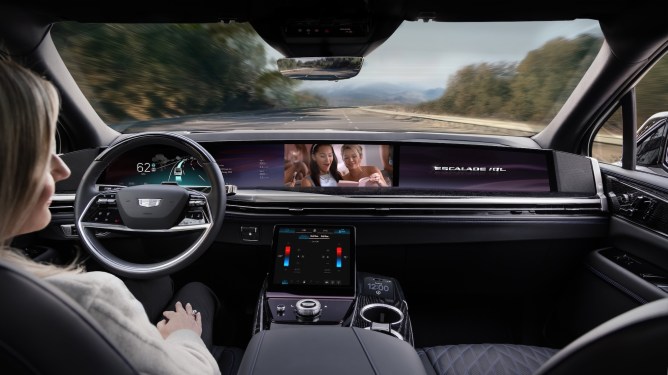General Motors has announced plans to launch an automated driving system in 2028 that will allow drivers to take their eyes off the road and their hands off the wheel. The system will debut with the Cadillac Escalade IQ. This news was shared at the GM Forward event in New York City. It follows an earlier report that the automaker was developing such a system.
The foundation for this future product is GM’s existing hands-off advanced driver assistance system, Super Cruise. Super Cruise launched in 2017 and is currently available in 23 vehicle models for use on about 600,000 miles of highway. This new eyes-off, hands-off system will also begin its operation on highways. It will use lidar, radar, and cameras for perception. GM CEO Mary Barra stated that the company intends to roll out this eyes-off product more quickly than it did with the Super Cruise system.
To improve the capabilities of this new system, GM is leveraging the experience of engineers from its now-closed autonomous vehicle subsidiary, Cruise. When GM shut down the Cruise robotaxi business in December 2024, it absorbed the subsidiary and integrated it with its own driver assistance development efforts. Over the past year, GM has rehired several Cruise engineers as it works toward its goal of creating fully autonomous personal vehicles.
GM is also incorporating Cruise’s technology stack into its next-generation programs. This technology includes AI models trained on five million driverless miles and a simulation framework for running virtual test scenarios.
During the event, Sterling Anderson, GM’s executive vice president of global product, explained that robotaxis initially made sense as a proof of concept. He noted that the high cost of sensors and computing for autonomous vehicles required high vehicle utilization. Anderson said the industry has now significantly reduced hardware costs. He stated that GM, with its large install base and manufacturing capacity, is uniquely positioned to produce these systems at larger volumes and lower costs. He suggested that if low-cost systems and large-scale production had been available from the start, the industry might have focused on personal autonomous vehicles first.
In the United States, Mercedes is currently the only automaker with a commercially available hands-off, eyes-off system. These systems fall under SAE Level 3 automation, meaning the automated system can drive itself under specific conditions but may still require a human to take control. The Mercedes Drive Pilot system is only available on certain mapped highways in California and Nevada and functions solely in heavy, low-speed traffic.
According to Baris Cetinok, GM’s senior vice president of software and services, GM’s eyes-off product will operate on highways that have not been pre-mapped by the company. He added that the system will only require human intervention for situations like navigating off-ramps and is designed to handle emergencies and sudden incidents. Cetinok emphasized that human intervention should not be the escape hatch for sudden incidents.
Launching an eyes-off, hands-off system would position GM ahead of most other automakers, provided others do not achieve this first. Earlier this year, Stellantis unveiled its own Level 3 system but has since put its launch on hold. Tesla has been working for years to solve full self-driving using only cameras and neural networks, though its Autopilot and Full Self-Driving systems still require the driver to keep their eyes on the road.

